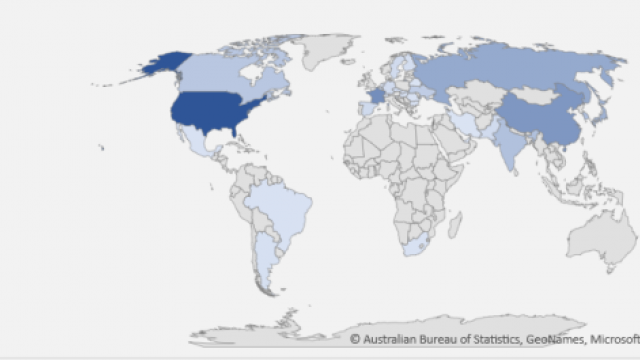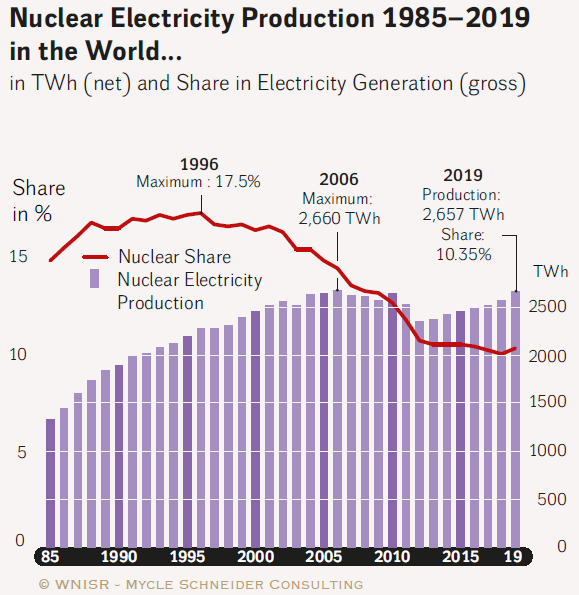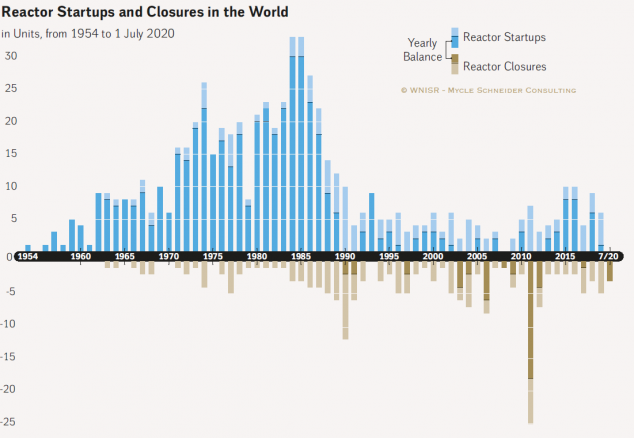
Nuclear energy worldwide 2021
Roughly, three groups can be distinguished: While some are striving to phase out nuclear energy, others are keeping their NPPs running, while still others are expanding their nuclear energy structures or promoting the development of new reactor concepts. In each case, plausible arguments are put forward: For example, supporters refer to the reliability with which nuclear energy is supplied or point to the low CO2 balance, which is seen as an advantage in the fight against climate change; opponents refer to the existing accident risk, the issue of disposal or high costs.
The different opinions are currently reflected exemplary in the discussion about the so-called taxonomy of the European Union, which is intended to define which economic activities in the EU can be assessed as “sustainable investments” in the future. It is not yet clear whether nuclear energy is included, and agreement is difficult due to the different positions of the individual member states.
This dossier provides an overview of nuclear energy worldwide. It is updated once a year and republished on the GRS website.
Situation in Germany
In Germany, 6 reactors are currently connected to the grid: Brokdorf, Emsland, Grohnde, Gundremmingen C, Isar 2 and Neckarwestheim. The last NPPs will be shut down at the end of 2022. The average age of the 6 reactors is 34.1 years. (The figures on average age in this text are based on the date commercial power operation started and present the status in January 2021 from the World Nuclear Industry Status Report). The 6 NPPs produced a share of 11.3 % in the electricity mix in 2020,
However, NPPs are not the only nuclear facilities in Germany. The 6 research reactors currently in operation may continue to be operated after 2022. The same applies to the so-called nuclear fuel cycle facilities. In addition to the storage and disposal facilities for radioactive waste, these include the fuel fabrication plant at Lingen and the uranium enrichment plant at Gronau.
Situation worldwide
There are currently 444 nuclear reactors in operation worldwide with an average age of 30.7 years, 50 units are currently under construction, 169 have been decommissioned or are currently being dismantled. Here and in the following, the figures are taken from the International Atomic Energy Agency (IAEA).
The World Nuclear Industry Status Report (WNISR) arrives at a somewhat lower number. This is because the IAEA figures include the so-called long-term shutdown reactors. These are reactors that are shut down for the long term but not finally shut down. The majority of these reactors are in Japan.
The share of nuclear energy in global electricity production has been fairly stable at between 10 and 11 % in recent years (here and in the following, the figures relating to the electricity mix are taken from the International Energy Agency (IEA) and reflect the situation in 2018) and is quite far from its record high (17.5 % in 1996). This decrease, however, is not due to less electricity being produced in NPPs. It is rather due to the fact that the relative share has fallen because renewables have been expanded, but above all because fossil power plants produce significantly more electricity in absolute terms than in previous years and decades.
whereas most of the reactors being dismantled are sited in Western Europe and North America. Accordingly, the average age of reactors in Asia is comparatively low. New reactor units also have a greater average output than those that have been decommissioned so that despite a decline in the number of reactor units, the installed capacity can increase.
The following overview shows the situation according to continent (Europe, America, Asia and Africa) Australia/Oceania is not included as no NPPs are operated there. After a brief summary, a selection of countries is presented for each continent that either operate a particularly large number of reactors or where new developments have taken place or are emerging. For a more detailed list of all countries, please refer to the IAEA's Power Reactor Information System (PRIS) or the World Nuclear Industry Status Report.
Europe
In Europe, nuclear energy accounted for approximately 23 % of the total electricity generation in 2018, thus occupying first rank. A total of 180 reactors are in operation in Europe, with an average age of 33.6 years. 15 reactors are currently under construction, 116 are being dismantled.
Western Europe
Nuclear energy in France accounts for the largest share in the electricity mix – in 2019, approximately 71 %. With 56 reactors, France is also the European leader in this respect. However, the last reactor was connected to the grid in 1999 and the average age is 35.1 years. A new unit is currently being built at the Flamanville NPP. The construction project began in 2007 and was originally scheduled for completion by 2012. However, the schedule was extended several times, and the costs have multiplied since then. Nuclear energy is also to play an important role in France's climate protection plans. At the beginning of the year, the French nuclear supervisory authority ASN announced that the operating lives of the 32 oldest reactors would be extended under certain conditions – from 40 to 50 years. France is also active internationally and has, among other things, recently submitted an offer to India for the construction of 6 new reactor units.
The United Kingdom also continues to rely on nuclear energy – about 17.4 % of its electricity comes from NPPs. Currently, 13 reactor units are in operation, 2 more are under construction (Hinkley Point C) and 30 reactor units are being dismantled. At the Sizewell site, 2 more units are to be built. According to the Johnson government's “Ten Point Plan for a Green Industrial Revolution”, Small Modular Reactors (SMRs) and Advanced Modular Reactors (AMRs) are to play an important role in the energy mix in the future. For example, the Rolls-Royce group has announced that it will produce SMRs. The smaller-scale reactors are to find customers both in the Kingdom and abroad – for example, Rolls-Royce is in talks with an Estonian start-up.
In addition, Belgium is particularly noteworthy, where 7 reactors cover almost half of the electricity needs. The reactors Doel 3 and Tihange 2 are scheduled for shutdown in 2022/2023. It is planned to shut down the other reactors, which are on average 47.6 years old, in 2025. However, this is subject to the proviso that this will not endanger the power supply in Belgium.
All in all, there is no major expansion activity in Western Europe; apart from France and the UK, only Finland is building a new unit (Olkiluoto) in addition to the 4 units that are operated, which will reduce the average age of 41.8 years. According to latest reports, commercial operation is scheduled to start in February 2022. For the construction of another reactor unit, the construction site has been prepared and the application for a construction permit submitted. All projects in Western Europe have in common that the originally calculated costs and construction times have massively increased.
Central and Eastern Europe
Ukraine's 15 reactors produce more than 50 % of the country's total electricity, and the government's energy strategy aims to maintain this level until 2035. To achieve this, it is planned to complete the reactor units Khmelnitsky 3 and 4, whose construction began in 1986 and 1987, respectively, but has been interrupted since 1990 due to a moratorium. The average age of the reactors, currently 31.9 years, will then fall. Talks are ongoing with South Korea, China and the Czech Republic for the construction projects. Lifetime extensions of some of the reactors currently in operation have been approved.
In Slovakia, in addition to the 4 reactors currently in operation which produce a share of approximately 54 %, 2 more will be commissioned in the near future. The situation is similar in Hungary where half of its electricity is currently generated by 4 reactor units. The construction of 2 new reactor units is being prepared. Nuclear newcomers are Belarus, Poland and Turkey: Poland plans to connect the first of a total of 6 reactors to the grid from 2033; in Belarus commercial operation of the first reactor unit is about to be started, the second is to follow next year; in Turkey, 4 reactor units are currently under construction.
In Russia, 19.7 % of the electricity mix is produced with nuclear energy, for which 38 reactors are connected to the grid with an average age of 27.8 years. In the last two decades, 12 new reactors have been commissioned, including the Akademik Lomonosov floating NPP. It is the first NPP to use SMRs for public power supply. Other units are planned or under construction. Russia is also very active abroad: In addition to Hungary and Belarus, Russia is planning or building new reactors for example in Finland, Iran, Turkey, Egypt, India and Bangladesh . Further cooperation is planned, especially with African countries.
America
In 2018, nuclear energy accounted for approximately 15 % of the total electricity mix in the Americas, where 120 reactors with an average age of 39.4 years are in operation. However, a clear North-South divide should be noted here: While 113 reactors are in operation in the USA and Canada, there are only 7 south of them. 4 units are currently under construction and 45 are being dismantled.
The United States operate 94 reactors, more than any other country in the world, providing 19.7 % of the electricity. The average age is 40.2 years. This figure is likely to rise in the coming years: Lifetime extensions of a majority of the reactors from 40 to 60 years have already been decided, a further extension to 80 years has already been approved for 6 reactor units, and extending operating licences to 100 years is at least being considered. However, since in some cases the retrofits required for such lifetime extensions would have been too expensive, several plants have been shut down, most recently the third and last unit at Indian Point in New York State. Nuclear energy is to play a greater role in the energy planning of the new President Joe Biden. Accordingly, the development of new reactor concepts, especially SMRs, is to be promoted. In addition, American companies are again increasingly interested in reactor projects abroad, such as in Poland, Romania and Bulgaria.
Almost 15 % of the electricity mix is produced by the 19 reactors (average age 37.5 years) in Canada. Although no new reactor units are under construction here, some SMR projects are promoted and some examined for their potential in feasibility studies. South of the USA, reactors are operated in only three countries: 3 in Argentina and 2 each in Mexico and Brazil. The share in the electricity mix in these countries was between 2.7 and 5.3 %. A new reactor unit is planned in Argentina, and in Brazil, work on the third unit was resumed after a six-year interruption.
Asia
In Asia, the share of nuclear energy is just 4 %. Seven countries operate a total of 142 reactors. Their average age is 19.1 years. In addition, 35 new units are under construction here – compared to 31 reactors that are being dismantled. On no other continent, nearly as many new NPPs are under construction. Here, it is to be taken into account that Asia's share of the world's population is more than 50 % and that energy needs have not multiplied as much in any other continent in recent decades.
Far East
Nuclear energy accounts for 4.9 % of the total electricity mix in China, which is generated by 50 reactors with an average age of just 8.6 years. 18 new reactors of various types are currently under construction – nuclear energy plays an important role in China's efforts to reduce CO2 emissions. This is also emphasised in its new 5-year plan, which includes further new reactors to be built. China is also pushing into new markets to sell its technology and expertise. In the UK, for example, a generic safety review has been completed for the Hualong One reactor type, and in Pakistan, 2 Hualong One reactor units are nearing completion.
In South Korea, the share of nuclear energy is much higher: 26.3 % is produced by the 23 reactors currently in operation. Although the government plans to phase out nuclear energy, the 4 reactor units under construction will be completed. 12 reactors are to be decommissioned by 2043. South Korea is also trying to get involved in construction projects in various countries. It is already active in the United Arab Emirates and talks are ongoing with the Czech Republic and Ukraine, for example.
Japan, of course, is one of the countries whose nuclear industry was strongly affected by Fukushima. Before the day of the disaster, 54 reactors were in operation there, covering almost 30 % of the country's electricity needs. These were all initially shut down after the disaster, 9 of which are now back on the grid. In contrast, there are 27 reactors that are currently being dismantled; their share in the electricity mix is 7.5 %. The remaining reactors are still shut down, and it is not yet clear what will happen next. A new reactor unit is currently under construction.
Following the events in Fukushima, Taiwan has decided to phase out nuclear energy. The remaining 4 reactors are to continue generating electricity until 2025 before they will be shut down.
The situation is different in India, where 6 more units are under construction in addition to 23 reactors in operation. The share of 3.2 % in the total electricity mix is thus expected to increase. These are India's own developments based on the CANDU reactor type as well as Russian type reactor units. The construction of 6 new reactor units of Western design is also planned.
Near and Middle East
Nuclear energy is also used to generate electricity in Pakistan: 6 reactor units cover approximately 6.6 % of the electricity needs here, 2 more are under construction. In Iran, the first reactor unit has been in operation for almost ten years and 2 more are under construction here as well.
In Asia, there are also a number of countries that are nuclear newcomers. These include Bangladesh, where 2 Russian design reactor units are currently under construction, and the United Arab Emirates: Barakah-1 recently started commercial operation, with 3 more to follow shortly (all Korean APR-1400).
Africa
Only two reactors are operated in the whole of Africa, producing about 1 % of the total electricity mix. They are both located in South Africa, where nuclear energy has a share of 6.7 %. Both plants were built at the same time and connected to the grid in 1984 and 1985, respectively, resulting in an average age of 36.1 years. There are currently no plans for other construction projects in South Africa.
The fact that nuclear energy production hardly takes place in Africa at present does not mean that it is not interesting for some countries. The power grids on the continent will have to be expanded in the coming years, and nuclear energy could play a role in this. China and Russia have already put out feelers.
The construction of a total of 4 Russian reactor units in Egypt, for example, is a done deal, with construction scheduled to begin in 2022. In addition, there are a number of agreements with African states that do not have a concrete timetable yet, but could certainly be realised. China has such agreements with Kenya, Sudan and Uganda. Russia is in talks with Algeria, Ethiopia, Ghana, Nigeria, Rwanda, Sudan and Zambia. With Namibia and Niger, Africa is also home to the fourth and fifth largest uranium producers.






